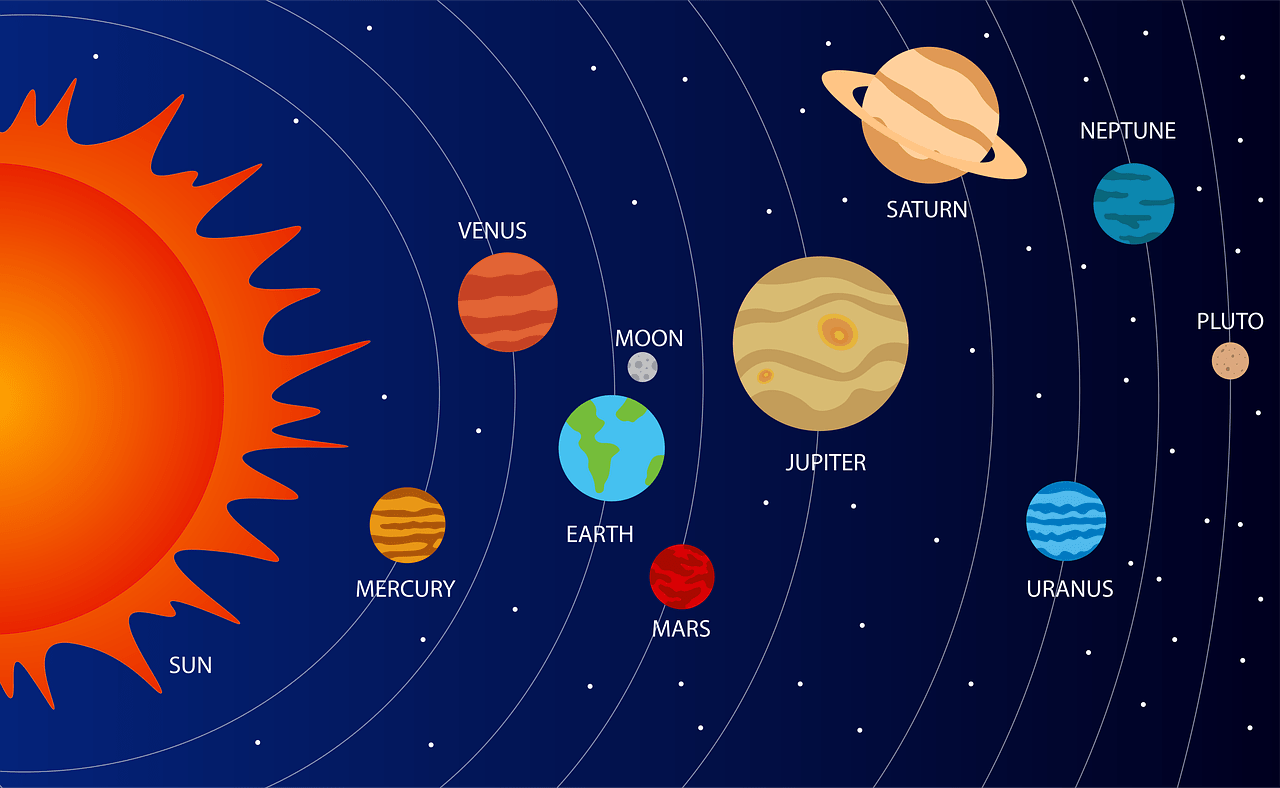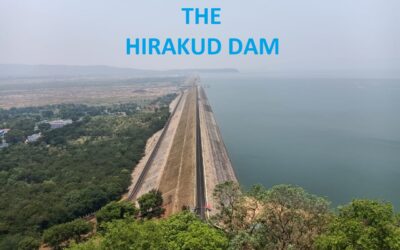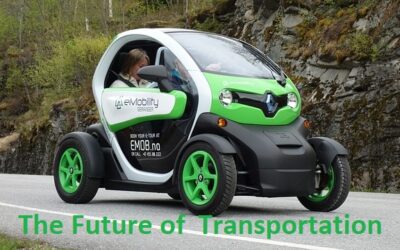
THE SOLAR SYSTEM
Solar system is the family of the Sun. The Sun is the head of the family. It has eight children called planets. Grand children are asteroids, meteors, satellite etc. Therefore, it is a small family of planets and satellites in our solar system. They all live together happily in a Grand house called “The Milky way”. Children and grandchildren love the head of the family so much that they keep revolving around it whole day. Everyone respects sun and therefore is regarded as a star of the family. It is the only star in the entire Solar System.
Now, if anyone asks you what is a solar system, you can easily answer that “the sun and all the objects that orbit (Revolve) around it”.
Let’s know more about the Planets
What are the eight planets in our solar system?
Sun has nine children known as planets. Their names are Mercury, Venus, Earth, Mars, Jupiter, Saturn, Uranus and Neptune. Mercury is the smallest and Jupiter is the eldest of all. I will tell you about all of them one by one.
1. MERCURY
Mercury is the youngest and the smallest among all and always remain close to the sun.
To take one complete round of sun, it takes almost 88 days.
With its small legs, it runs at a speed of only 48 km per hour.
Your weight on mercury will be only 38% of your weight on earth.
As it is very close to the sun, therefore, it is extremely hot.
From the sun, it is 36,000,000 miles or 58 million km.
To travel from Sun to Mercury, sunlight takes 3.2 minutes.
2. VENUS:
It is the second planet in our solar system.
Venus is slightly bigger than Mercury.
It shines very bright in the sky therefore also known as “Morning star”.
As it is also near to the sun, it is extremely hot and has poisonous gases .
From the earth it is close therefore it looks very bright.
It takes 225 days to complete one revolution around the sun at a speed of 35 km per hour.
Distance between sun and Venus is 68,000,000 miles OR 108,000,000 Km.
Sunlight take 6 minutes to reach to Venus https://www.gyanimaster.com/2019/04/venus-planet-facts-in-hindi.html .
3. EARTH
Next to Venus, the third planet in our solar system is the Earth.
This is the only planet where life exists .
Earth has both – air (Oxygen) and water.
If you see earth from space, it will look blue in color.
Earth is neither too close nor too far from sun.
Therefore it is neither too hot nor too cold.
The climatic conditions are very favorable.
It takes 24 hours to complete one Rotation and 365 days and 6 hours to complete one revolution of the sun पृथ्वी की गतियां.
Distance from sun is 149 million km.( 92.5 million miles)
Sunlight takes 8 minutes and 20 seconds to reach to earth.
It has a beautiful natural satellite called Moon.
This moon also rotates and revolves around the earth.
4. MARS:
It is the fourth and second smallest planet in our solar system.
Presence of iron oxide, makes it look red.
therefore people also call it as a “Red planet.”
Due to its red color, many think that it is extremely hot planet but is not true.
Mars is a comparatively cooler planet than earth.
The temperature on Mars is -60 degree Celsius and during winter it goes up to – 125 degree Celsius.
Because of very thin layer of atmosphere, it cannot retain heat and thus is very cold.
It takes 687 earth days to complete one round of sun.
Distance from sun is 142 million miles or 22.85 crore km.
Sunlight takes 12.4 minutes to reach up to mars.
If you go to Mars, you can see two moons – Phobos and Deimos.
India is the fourth country to land on Mars.
“Mission Mangal” also known as Mangalyaan launched by ISRO landed on Mars in November 2013.
5. JUPITER
It is the eldest son of Sun and biggest among all planets.
If you combine all other 7 planets then half Jupiter will be ready.
It means if Jupiter were the size of Basket ball, Earth would be the size of a grape.
It has giant red spots.
Jupiter takes only 10 hours to complete one rotation whereas earth takes 24 hours.
Due to its high speed, Jupiter bulge at the equator and is flattened at the poles like our earth.
It has 79 known moons.
Four largest moons on Jupiter are Lo, Europa, Ganymede and Calisto which were discovered by Galileo.
Ganymede is the largest moon and is bigger than Mercury.
Frequent volcanic eruption takes place on the surface of Jupiter.
Distance between Jupiter and sun is 483,682,810 miles (778,412,020 km).
6. SATURN

SATURN WITH BEAUTIFUL RINGS
Next to Jupiter is Saturn which is the second largest planet in our solar system.
It is the most beautiful planet among all.
60 moons and icy ring around it make it a unique planet.
Saturn is 9 times wider than earth.
It is a massive ball made up of Hydrogen and Helium just like Jupiter.
Saturn is 886 million miles ( 1.4 billion kilometers) from sun.
sunlight takes 80 minutes ( 1hour and 20 minutes) to reach to Saturn.
It has the second shortest day in the solar system.
It completes one full rotation in just 10.7 hours.
To complete one full revolution of sun, it takes 29.4 earth years ( 10,756 earth days).
It is titled by 26.7 degrees just like earth.
The ring around Saturn is mostly made up of ice and dust coated rocks.
7. URANUS
Uranus is the 7th planet of our solar system.
It is so much tilted that its axis almost point directly to the sun.
It is believed that it’s tilt is because of collision with a planet.
Uranus is 16 times bigger and 14.5 times heavier than our earth.
It takes 17hours and 14 minutes to complete one full rotation on its axis.
Uranus is one of the coldest planets in our solar system. The minimum temperature recorded is -227 degree Celsius
It has 27 natural moons and all are named after Alexander Pope and Shakespeare’s novel characters.
Titania is the biggest moon of Uranus.
It is 278 crore km away from sun.
Sunlight takes 2 hours and 40 minutes to reach Uranus.
Few most interesting facts about Uranus are:
i) It is the first planet to be discovered.
ii) Do you know that it was discovered before Antarctica continent.
iii) It is tilted by 97.77 degrees therefore, one part of Uranus receives sunlight for 42 years and the other part remains in dark for almost the same time.
Like Venus, Uranus revolves around the sun in opposite direction ( East to West).
8. NEPTUNE
It is considered to be the eighth and last planet of our solar system.
In size, it is the fourth largest planet after Jupiter, Saturn and Uranus.
It is almost 450 crore kilometers away from sun.
Neptune has 14 natural moons (satellites)
The largest moon is Triton.
Though it is the farthest planet but not the coldest because Neptune’s atmosphere helps to retain heat from its hot core.
PLUTO: THE DWARF PLANET IN OUR SOLAR SYSTEM
Pluto was declared as a planet on 24th March 1930.
It was known as the ninth and the farthest planet of our solar system till 2006.
Today Pluto is no longer considered as a planet.
What is the difference between a star and a planet ?
- A star is very big as compared to planet.
- Stars have their own heat and light but planets do not.
- Stars do not revolve around any object but planets revolve around star.
- There are countless stars whereas planets are countable.
- some of the stars are Sun, Polaris, Sirius, Alpha century etc. Some of the planets are Earth, Mercury, Jupiter, Saturn etc.
What is the difference between a Planet and a Satellite?
- Planets revolve around a star whereas a satellite revolve around a planet.
- Planets are natural celestial bodies but satellites can be both Natural and artificial.
- Gravity and mass of planet is more as compared to satellites.
- Jupiter is the largest planet whereas Ganymede is the largest satellite.
- Examples of planets are Mercury, Venus, Earth, Mars etc. Examples of satellites are Ganymede, Triton, Aryabhata (Artificial), Sputnik (Artificial) etc.
Solar Eclipse:
Earth revolves around the sun. Similarly the moon also revolves round the earth. In this process when the moon partially or completely comes in between Sun and the earth, it blocks the sunlight and its shadow falls on the earth. It can be defined as “Though this is beautiful natural sight but many in India do not consider it to be auspicious. Last on 22nd July 2019, complete solar eclipse was seen in India. This lasted for 6 minutes and 38 seconds. It means the sun was totally covered by moon and was not visible for approx. 7 minutes.
Now, you must be wondering how can a small object like moon can cover sun which is 400 times bigger. It is easy to understand. Place a book in front of your eyes at a distance of 1-2 feet. Can you see the tree, bus, building anything. No. Though the size of your notebook is very small then also it obstructs the visibility because it is very close to you. Similarly, moon is close to the earth, therefore hides the sun easily during the solar eclipse.
In India many people do not cook, go out or eat anything during the Solar eclipse.
People believe that both the negative energy and effect of eclipse can cause negative impact on our health, body and mind.
Some do’s and don’ts during Solar eclipse .
Lunar Eclipse:
In case of Lunar eclipse, the Earth comes in between the sun and the moon.
The shadow of earth falls on moon and moon becomes dark means invisible.
The last Lunar eclipse was seen on 30th November.
Just like solar eclipse, Lunar eclipse is also not considered auspicious.
Two types of lunar eclipses are
i) Total lunar eclipse and ii) Partial lunar eclipse .
Other heavenly bodies in our Solar system
Meteoroids:
Meteoroids are rocky and metallic body in outer space.
They are smaller than Asteroids.
In the space they are available in different sizes.
It’s size differs from small grains to one meter wide.
They are like space rocks.
Meteors:
You must have seen stars breaking and falling from the sky.
But, those are not the stars. If a star falls on earth, the earth will burn completely.
Actually when a Meteoroid enter in the earth’s atmosphere they start burning due to high friction.
This at night looks as shooting stars. It falls at a speed of 20 kms/sec.
Meteorites:
When a Meteor successfully enters the earth’s atmosphere and reaches the earth, they are known as Meteorites.
Scientists believe that about 44,000 kms of Meteoritic material fall on earth everyday.
ASTEROIDS:
Asteroids are the rocks floating in the space.
They also revolve around the sun.
You can see many asteroids between Mars and Jupiter.
They are very light.
It can be as big as 33 feet.
Comets
Comets are like snow balls.
They are either rock, dust or ice particles.
They resemble like a dust storm in the sky.
Because of its movement and speed, it stretches and looks like as if it has got a head and tail.
When frozen, they can be as big as a town.
Class VI Geography: “The earth in our solar system”
Q1. How does a planet differ from a star?
Ans. mentioned above. Pl. refer.
Q2. What is meant by solar system?
Ans. It is a system in which all eight planets, satellites and other celestial bodies revolve around the sun.
Q3. Name all the planets according to their distance from the sun.
Ans. Mercury, Venus, Earth, Mars, Jupiter, Saturn, Uranus and Neptune.
Q4. Why is Earth called a unique planet?
Ans. Earth is called a unique planet because
i) it has favorable climate which supports life.
II) it is the only planet which has water.
III) Temperature here is neither too hot nor too cold.
Q5. Why do we see only one side of the moon always?
Ans. We see only one side of the moon always because:
I) Moon takes 27.3 days to complete one full revolution of earth.
II) It rotates exactly at the same speed as it rotates around its own axis.
III) Therefore, same side of the moon is constantly facing the surface of the earth.
Q6. What is the universe?
Ans. Universe is a body which is extremely big and endless.
It has all the stars, planets, satellites and other heavenly bodies.
Conclusion:
Hope you like this article on solar systems. Do write your queries and suggestions.
Also, share with your friends.
Class 6 History Chapter 1 What, Where, How, and When Lesson Plan 2023
Class 6 History Chapter 2 From Hunting – Gathering To Growing Food Lesson Plan





0 Comments